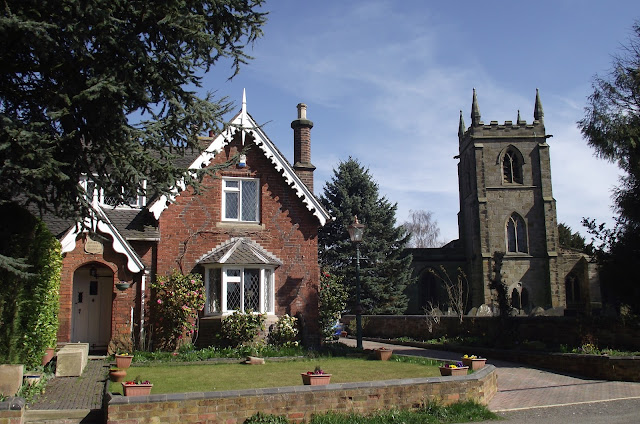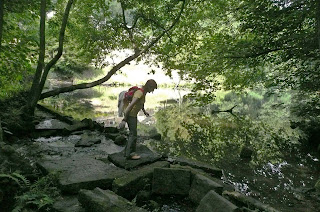Apparently it was as hot in Derbyshire today as it was in Madrid. Wow! Certainly a very warm and beautifully sunny day.
We went for a walk at a place I had never explored before - Osmaston estate near Ashbourne. There used to be a huge Italianate house here in Victorian times, but it was demolished in the 1960s. The pretty estate village remains. It its one of the few places in Derbyshire where there are many thatched cottages. Obviously the folks at the big house liked their villages rustic and picturesque.
We walked past the bustling Shoulder of Mutton pub and the diminutive village post office ("Ring for attention"), and turned left at the village duck pond. Several people had set up deckchairs by the water and were enjoying the sunshine.
There was a lovely old tree in a field by the footpath. It had a swing and it was very tempting to have a go, but I felt a bit sorry for the tree! Here I am trying to take a photo of it with my tablet PC.

Descending a slope we came to the estate water mill, a building with a somehow Alpine look to it.
Its delapidation only makes it more picturesque. We especially liked the tufty ferns sprouting from the roof tiles.
From thence we made our way across fields for a mile or so until we reached the charming hamlet of Shirley. Here there is a remarkable 'survivor' tree. It is built into the wall of the village church, and the metal fence along the top of the wall goes through it. The tree has at some point been cut down to a stump, yet still has twigs and bugs growing, despite being completely hollow and riddled with woodworm!
Across from the tree and the church is the Saracen's Head pub, which is very neatly kept. Inside the hostelry everyone was happily nibbling on tasty roast dinners http://www.saracens-head-shirley.co.uk/ Only having a fiver on us and being as we were saving up for our holidays we could only afford a cup of tea and an orange juice. So we sat at a bench outside and dribbled over the puddings menu (eg "Vanilla Pan Cotta with Lavender Cookies").
After leaving Shirley our route led through some dry sandy fields. The fields had a spring green colour to them and the sky was impossibly blue. It certainly didn't feel like March. I collected some of the pebbles which filled the fields, intending to take them home and make them into owls for the garden.
From thence into a quiet wetland area. Someone had constructed an very sturdy boardwalk to carry the footpath over a marshy area of rushes. It was nice to sit and bask on the boardwalk for a while.

Then into some conifer woodland and eventually we emerged to a small lake. From the shore, the one remaining tower of former Osmaston Hall could be seen in the far distance, cloaked by trees. Along the lake was a line of alders, their roots making little islands along the water's edge.
Up a steep incline past a twisted stag headed oak and then out through the tall gateway that once led to the hall, back to the pretty "village ornee" of Osmaston for a cup of tea and a slice of cake which we had brought along with us. What a nice walk!
 |
| The former Osmaston Hall |
We went for a walk at a place I had never explored before - Osmaston estate near Ashbourne. There used to be a huge Italianate house here in Victorian times, but it was demolished in the 1960s. The pretty estate village remains. It its one of the few places in Derbyshire where there are many thatched cottages. Obviously the folks at the big house liked their villages rustic and picturesque.
We walked past the bustling Shoulder of Mutton pub and the diminutive village post office ("Ring for attention"), and turned left at the village duck pond. Several people had set up deckchairs by the water and were enjoying the sunshine.
 |
| Another pretty cottage in the village |
There was a lovely old tree in a field by the footpath. It had a swing and it was very tempting to have a go, but I felt a bit sorry for the tree! Here I am trying to take a photo of it with my tablet PC.

Descending a slope we came to the estate water mill, a building with a somehow Alpine look to it.
Its delapidation only makes it more picturesque. We especially liked the tufty ferns sprouting from the roof tiles.
 |
From thence we made our way across fields for a mile or so until we reached the charming hamlet of Shirley. Here there is a remarkable 'survivor' tree. It is built into the wall of the village church, and the metal fence along the top of the wall goes through it. The tree has at some point been cut down to a stump, yet still has twigs and bugs growing, despite being completely hollow and riddled with woodworm!
Across from the tree and the church is the Saracen's Head pub, which is very neatly kept. Inside the hostelry everyone was happily nibbling on tasty roast dinners http://www.saracens-head-shirley.co.uk/ Only having a fiver on us and being as we were saving up for our holidays we could only afford a cup of tea and an orange juice. So we sat at a bench outside and dribbled over the puddings menu (eg "Vanilla Pan Cotta with Lavender Cookies").
After leaving Shirley our route led through some dry sandy fields. The fields had a spring green colour to them and the sky was impossibly blue. It certainly didn't feel like March. I collected some of the pebbles which filled the fields, intending to take them home and make them into owls for the garden.
From thence into a quiet wetland area. Someone had constructed an very sturdy boardwalk to carry the footpath over a marshy area of rushes. It was nice to sit and bask on the boardwalk for a while.

Then into some conifer woodland and eventually we emerged to a small lake. From the shore, the one remaining tower of former Osmaston Hall could be seen in the far distance, cloaked by trees. Along the lake was a line of alders, their roots making little islands along the water's edge.
Up a steep incline past a twisted stag headed oak and then out through the tall gateway that once led to the hall, back to the pretty "village ornee" of Osmaston for a cup of tea and a slice of cake which we had brought along with us. What a nice walk!





































